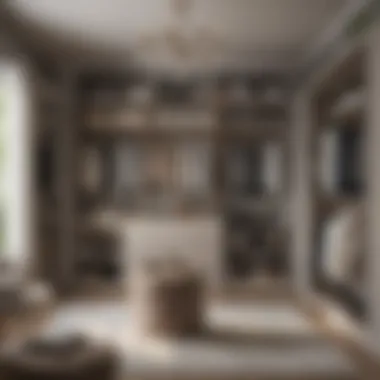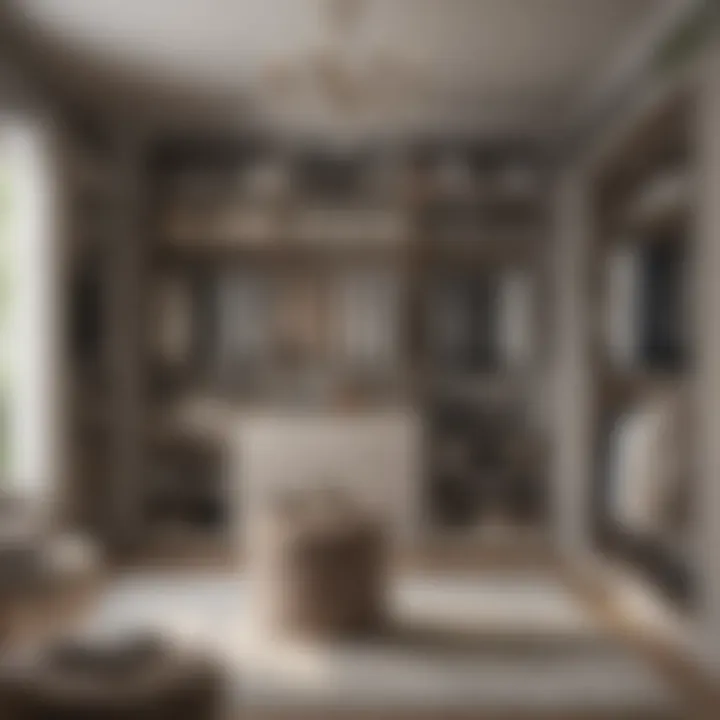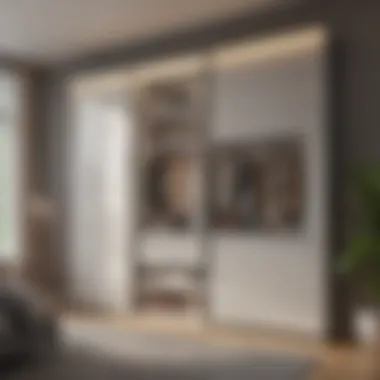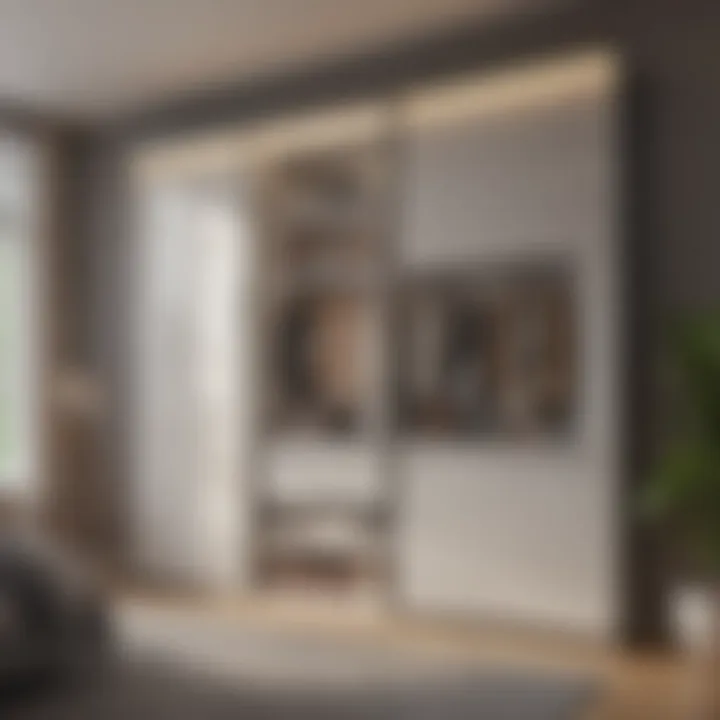The Anatomy of Nice Bedroom Closets: Design & Functionality


Intro
Bedroom closets are more than mere storage spaces. They hold potential to transform a room's functionality and overall appeal. Understanding the design and organizational aspects is key for any housewife or homeowner looking to enhance their living space. In this guide, we will dissect the importance of a well-designed closet. We will talk about trending styles and color palettes that can significantly change your closet's ambiance.
By the end of this article, you will have actionable insights into creating a stylish and organized closet that reflects your personal taste.
Design Inspirations
Creating a closet that is both functional and visually appealing starts with design inspirations. It's essential to consider current trends and how they fit into your existing space.
Trending Styles
Various styles can be applied to bedroom closets. Here are some popular choices:
- Contemporary: Clean lines and minimalistic aesthetics define contemporary designs. They typically use materials such as glass and metal, providing a sleek look.
- Rustic: This style incorporates natural wood elements. It often features open shelving and distressed finishes, offering a warm and inviting feel.
- Industrial: Industrial designs embrace metals and raw finishes. They can create an urban chic vibe.
- Traditional: Traditional closets may include more ornate details such as crown molding and rich finishes, appealing to those who prefer classic looks.
Choosing the right style can instantly elevate the closet experience.
Color Palettes
Color plays a pivotal role in setting the tone. Certain palettes can create a sense of openness and calm, while others may add warmth and energy. Some noteworthy suggestions are:
- Neutrals: Whites, beiges, and grays provide a timeless backdrop. They complement most designs and can make closets appear larger.
- Pastels: Soft pinks, blues, and greens offer a soothing ambiance that feels tranquil.
- Bold Colors: If you're aiming for a statement piece, consider deep jewel tones. They can add drama and draw the eye.
Choose colors that resonate with your personality. A well-thought-out color scheme can enhance both functionality and aesthetics in your bedroom closet.
Product Recommendations
Once you have established your design and color preferences, it's essential to select products that align with your vision. Here are some recommendations.
Accessories
Incorporating functional accessories improves organization:
- Storage Bins: These can store off-season clothing, keeping items organized and hidden.
- Hangers: Invest in high-quality hangers that fit specific garments to maintain their shape.
- Shoe Racks: These help keep shoes visible and accessible, avoiding clutter on the floor.
Bedroom Essentials
Essential items every closet should have include:
- Full-Length Mirror: It adds functionality and offers convenience while getting dressed.
- Lighting: Proper lighting helps find items easily and adds to the overall ambiance.
- Drawer Organizers: These keep smaller items tidy and easy to locate.
A carefully curated selection of products will maximize the usability of your closet.
Ending
In summary, a well-designed bedroom closet combines style and functionality. Selecting the right designs, colors, and products allows for a personalized touch.
"Investing time in closet organization will lead to a more serene and enjoyable bedroom experience."
Use this guide as a starting point to create a space that not only meets your needs but also reflects who you are.
Prelude to Bedroom Closets
The bedroom closet serves a critical function in modern living environments. It is more than just a space to store clothes and accessories. This area significantly impacts the overall organization and flow of the bedroom. A well-designed closet can enhance the aesthetic appeal while offering practical benefits such as increased storage capacity and better accessibility. Its importance cannot be overlooked, especially in an era where maximizing space in a home is essential.
Definition and Importance
A bedroom closet can be simply defined as a small room or enclosed space used primarily for storing clothing, shoes, and other personal items. However, its importance transcends this basic definition. A well-structured closet promotes an organized lifestyle, allowing individuals to find items quickly, reducing time spent searching for clothing. In addition, a functional closet can prevent clutter from overtaking the bedroom, thus promoting a calm, serene atmosphere conducive to relaxation and rest.
Furthermore, the closet’s design can reflect personal style. Whether minimalistic or elaborate, the closet contributes to the bedroom’s overall aesthetic. It is vital for homeowners to pay attention to the closet’s visibility and functionality, ensuring that it aligns with their lifestyle and preferences.
The Role of Closets in Bedroom Design
Closets play a pivotal role in the overarching design of a bedroom. They can complement or contrast with the remaining interior design elements, such as color, materials, and layout. For instance, an open closet might use stylish shelving and display items in an artistic manner, becoming a feature of the bedroom.
In addition, organizing the closet effectively can lead to smarter use of floor space, making the room appear larger. Closets that are specifically designed to optimize space and storage can significantly influence how one interacts with their bedroom. The right layout allows for an efficient workflow, where items are easily accessible, and personal items can be displayed or stored in a manner that is both appealing and functional.
Ultimately, when considering a bedroom's design, attention to the closet cannot be neglected. An effective integration of the closet design into the bedroom can lead to a cohesive, stylish environment that enhances the comfort and functionality of the space.
"A thoughtfully designed closet transforms storage needs into a visual delight, merging function with personal expression."
Types of Bedroom Closets
Understanding the different types of bedroom closets is crucial for anyone looking to optimize their bedroom storage and aesthetics. Each closet type has unique characteristics that cater to various space limitations, storage needs, and personal styles. By recognizing these variations, one can select the most suitable option that aligns with their preferences and functionalities. In this section, we will explore four primary closet types: walk-in closets, reach-in closets, built-in closets, and armoires or freestanding closets. This examination will highlight the benefits and considerations associated with each type.


Walk-in Closets
Walk-in closets represent the embodiment of luxury and functionality. They offer ample space for storing clothing, accessories, and more. Typically designed as a separate room or a significantly large space, walk-in closets provide the opportunity for organization and personalization.
One of the main advantages of a walk-in closet is its capacity. With enough room to move around, homeowners can incorporate various storage solutions like shelves, drawers, and hanging rods. This versatility allows for optimal space utilization.
"A well-designed walk-in closet can significantly elevate any bedroom's overall aesthetic and functionality."
However, walk-in closets require a considerable amount of space, making them impractical for smaller bedrooms. It is essential to have a layout that supports this arrangement effectively, often necessitating professional design expertise to maximize storage without sacrificing accessibility.
Reach-in Closets
Reach-in closets are commonly found in many homes, particularly in smaller bedrooms. These closets are characterized by their compact, linear design, usually featuring sliding or hinged doors. While less spacious than walk-in closets, they still serve practical storage needs.
The primary advantage of reach-in closets is their space efficiency. They can fit snugly into almost any bedroom layout, making them accessible for a wide range of homes. Organization is key here; incorporating shelves, hooks, and organizers can turn even a small reach-in closet into an effective storage space.
However, reach-in closets may limit the amount of clothing that one can store, especially if exterior space is not used effectively. Therefore, careful planning regarding interior layout is vital for maximizing usability.
Built-in Closets
Built-in closets are custom designs that are integrated into the structure of the bedroom. They provide a seamless look, enhancing the overall design of the space. These closets can be tailored to fit specific dimensions and storage requirements.
The benefits of built-in closets include enhanced aesthetic appeal and adaptability. Since they are designed to fit the space perfectly, they often include features like hidden compartments and specialized storage solutions that reflect the owner’s tastes.
However, built-in closets can come with a higher price tag due to the custom nature of their designs. They often require professional installation, adding to the initial investment. Yet, the long-term benefits of increased storage efficiency and improved bedroom aesthetics can justify the cost.
Armoires and Freestanding Closets
Armoires and freestanding closets present an alternative for those who desire flexibility or have limited space. They are standalone furniture pieces that can be relocated and reconfigured as needed.
These types of closets often come in various styles and sizes, allowing homeowners to express their personal taste while providing efficient storage. The versatility of armoires is particularly appealing, as they can serve multiple purposes like storing linens or serving as a decorative element in a room.
One drawback, however, is that freestanding closets might not offer as much storage space as built-in or walk-in closets. Their effectiveness largely depends on the available size and design of the selected piece.
In summary, choosing the right type of bedroom closet involves consideration of space, functionality, and personal style. Each type offers unique benefits that cater to different needs, making the selection process critical for achieving an organized and aesthetically pleasing bedroom.
Design Considerations for Bedroom Closets
When embarking on the journey of planning or renovating a bedroom closet, it is crucial to focus on the design considerations. These elements can significantly influence not just the closet's functionality but also the entire bedroom ambiance. Thoughtful design can optimize the use of space, enhance accessibility, and contribute to a calm and visually appealing environment. In this section, we will examine key considerations including space, materials, color schemes, and lighting solutions that contribute to making a bedroom closet not only practical but also stylish.
Space and Layout
The first step in designing a bedroom closet involves understanding the available space. This means measuring the area accurately and planning the layout accordingly. A well-planned layout can transform a small, cramped closet into a functional area without sacrificing style. Evaluate the depth and width of the closet to decide on the type of shelving, hanging rods, and storage solutions that will best utilize the space. If the closet is a walk-in, it’s possible to add features like a center island for additional storage or a bench for convenience.
Effective space management also allows for different types of storage—such as drawers, shelves, and hanging spaces—based on the items being stored. Assessing what clothing and accessories will be kept can help tailor the layout to meet specific needs.
Materials and Finishes
Choosing the right materials and finishes is another crucial factor in closet design. The materials impart not only durability but also an aesthetic appeal to the space. Solid wood is a popular choice for its classic look, but options like plywood or laminate can offer a more budget-friendly alternative without compromising on style.
Finishes also play a vital role. Glossy finishes can reflect light, making a smaller space feel larger, while matte finishes can impart a more subdued and sophisticated touch. It’s wise to consider how materials will interact with the bedroom’s overall design theme.
Color Schemes
Color schemes should not be overlooked in closet design. The right colors can influence mood and perception. For smaller closets, light colors can create a sense of openness, while darker colors can add depth and richness. If the closet is integrated into the bedroom space, it is advisable to harmonize its color with the existing color palette of the bedroom to maintain a cohesive look.
Also, consider adding accent colors for doors or hardware to create visual interest without overwhelming the space. Experimenting with different shades can also align with seasonal trends or personal preferences, allowing for a customized touch to the closet environment.
Lighting Solutions
Lighting is among the most significant yet often neglected aspects of closet design. Proper lighting can make tasks easier and elevate the overall aesthetic. Consider various lighting solutions such as built-in LED lights, which can be motion-sensored for ease of use. These lights provide bright and focused illumination, helping to find items quickly.
Incorporating ambient lighting can enhance the closet's atmosphere, making it more inviting. It can be beneficial to add accent lights on shelves or inside drawers to ensure visibility of items stored within. This way, not only does the closet serve its purpose effectively, but it also adds an element of design to the overall bedroom space.
Key Takeaway: Thoughtful design considerations in bedroom closets can significantly enhance functionality and aesthetic appeal, making a difference in daily routines.
By focusing on these design aspects, homeowners can create a closet that not only serves practical purposes but also adds to the overall beauty of the bedroom.
Organization Strategies for Bedroom Closets
Effective organization of a bedroom closet is crucial for maximizing both functionality and aesthetics. A well-organized closet greatly enhances the overall bedroom experience by providing ease of access to items and reducing clutter. In today’s fast-paced lifestyle, having a closet system that caters to individual needs can also save time when dressing and selecting outfits.
Consideration of organization strategies can transform any closet into a more usable and visually appealing space. Every element, from arrangement to storage types, plays a vital role in achieving this end goal.
Maximizing Vertical Space
One of the most effective organization strategies is maximizing vertical space. Many closets have a significant amount of unused height that can be utilized. Installing additional shelves or hooks is a simple way to take advantage of this space. Think about placing seasonal items or less frequently used things on higher shelves.


When arranging your closet, it is helpful to keep frequently used items at eye level. This avoids the trouble of stretching or using a stool every time you need something. Utilizing hangers with cascading functionality can also help use vertical space effectively.
Using Storage Bins and Baskets
Storage bins and baskets can play a significant role in keeping items organized and accessible. These containers help categorize belongings. Clear bins are particularly useful because they allow for easy visualization of contents. Labeling bins is also a practical way to find things quickly without unnecessary digging.
Baskets can be used for softer items like scarves or hats, keeping them neatly organized and within reach. This strategy not only organizes your closet effectively but also adds to the overall aesthetic. Choosing bins or baskets that complement your closet’s color scheme can create a cohesive look.
Incorporating Shelving Systems
Incorporating shelving systems can drastically improve closet organization. Adjustable shelving allows for customization according to varying item sizes. This flexibility makes it easy to adapt the space as your storage needs change over time.
Floating shelves can also be an excellent option for displaying shoes or handbags. They add a personal touch while keeping items off the floor. Open shelving systems make it easy to choose outfits without having to sift through various layers. This strategy also encourages maintenance since items are visible and easily accessible.
Seasonal Wardrobe Management
Managing a seasonal wardrobe is another key strategy for closet organization. Rotating clothing by season reduces clutter and allows for easy access to current wardrobe essentials. Off-season clothing can be stored in bins or under the bed to free up space in the closet.
Overall, keeping track of seasonal items and adjusting the closet accordingly prevents overcrowding. This also helps to visually streamline the closet, making it a more pleasant space to use day after day.
A well-organized closet not only saves time but also enhances the aesthetic appeal of your bedroom.
Adopting these organization strategies for bedroom closets can significantly enhance both the functionality and look of your space. Each method discussed allows for the meticulous arrangement of items while embracing personalized style and usability.
Innovative Features for Modern Closets
In today's fast-paced world, bedroom closets have evolved from mere storage spaces to integral components of bedroom design. Innovative features can transform a standard closet into a multifunctional area that enhances not only organization but also efficiency and aesthetics. This section delves into three key areas that modern homeowners should consider when designing or upgrading their closets: Smart Technology Integration, Customizable Closet Systems, and Sustainability in Closet Design.
Smart Technology Integration
The integration of smart technology into bedroom closets is becoming more prevalent. Homeowners now aim for features that enhance usability and convenience. Smart lighting systems can automatically illuminate the closet when the door opens, facilitating ease of access. Additionally, some systems allow for remote control via smartphones, enabling users to manage lighting or temperature settings without entering the closet.
Smart inventory management is another valuable feature. By utilizing RFID tags or similar technology, individuals can keep track of clothing items. An app could notify users about what they have and even suggest outfits based on the weather.
Incorporating these smart technologies can provide significant benefits:
- Convenience: No more fumbling in the dark or forgetting what is in your closet.
- Efficiency: Streamlined access to the wardrobe makes getting dressed less time-consuming.
Customizable Closet Systems
Customizable closet systems are essential for maximizing space and personalizing storage solutions. These systems allow homeowners to tailor their closet designs to fit their specific needs and preferences. Modular storage solutions offer flexibility, easily adapting to changes in wardrobe size or personal style.
Consider options like adjustable shelving, pull-out drawers, and integrated shoe racks. Each of these elements provides functionality while enhancing the visual appeal of the closet.
Customization offers several important advantages:
- Optimized Space: Every inch counts in a closet, so systems designed to suit individual needs can make even small spaces feel spacious.
- Design Cohesion: A personalized closet complements overall bedroom aesthetics, ensuring that it is not just a storage area but a cohesive part of the room’s design.
Sustainability in Closet Design
Sustainability is gaining traction in all areas of home design, including closets. Eco-friendly materials and practices are essential for those looking to reduce their environmental impact. Choosing sustainable materials for cabinetry and shelving, such as recycled wood or responsibly sourced timber, reflects an eco-conscious mindset.
Moreover, energy-efficient lighting options, like LED fixtures, further enhance the sustainability of the space. Beyond materials, consider donating unused clothing and utilizing natural storage solutions to promote a minimalist approach that prioritizes quality over quantity.
Incorporating sustainability into closet design offers multiple benefits:
- Long-lasting Impact: Sustainable materials tend to be more durable, resulting in longer-lasting designs that require less frequent replacement.
- Aesthetic Appeal: Many eco-friendly materials provide a unique charm and character that can elevate the overall look of the closet.
"Sustainability in closet design is not just a trend; it's a commitment to the environment and personal longevity."
In summary, innovative features in modern bedroom closets address the needs of contemporary lifestyles. Smart technology streamlines daily routines, customizable systems optimize space, and sustainability promotes responsible living. Together, these elements create an organized, beautiful, and efficient closet that enhances the bedroom experience.
Tips for Upgrading Your Bedroom Closet
Upgrading your bedroom closet can significantly enhance both its functionality and aesthetic appeal. This section will outline key tips to consider when embarking on this venture. Upgrading is not just about aesthetics; it involves a thoughtful assessment of your storage needs based on your lifestyle. By applying specific strategies, you can transform your closet into an organized and visually pleasing space.
Assessing Your Needs
Before making any adjustments, it is imperative to assess your current storage situation. Take stock of what you own, including clothing, accessories, and shoes. Consider the following elements:
- Current Usage: Analyze what items you access most frequently. Keep these items at eye level or easier reach.
- Seasonal Needs: Determine if your wardrobe changes seasonally. You may need a system that accommodates rotating items more effectively.
- Future Implications: Consider any lifestyle changes that may increase or decrease your storage requirements, such as moving, a new job, or family growth.
Engaging in a thorough evaluation of your needs can provide clarity on what upgrades will be most beneficial for your closet.
Budgeting for Improvements
Financial planning is a crucial step in your upgrade project. Knowing your budget helps set realistic expectations. Here are some points to keep in mind:


- Estimate Costs: Research materials, storage solutions, and any professional services you may use. Costs can vary widely based on materials and design complexity.
- Set Priorities: Identify which elements of your closet upgrade are essential and which are more cosmetic. Prioritize spending on items that will enhance functionality over aesthetics, if necessary.
- Consider Long-Term Investment: While some upgrades may have higher upfront costs, they can offer savings and added value in the long run. For instance, durable shelving may end up costing less than frequent replacements.
Establishing a clear budget creates a framework that prevents overspending and ensures that all necessary aspects are covered.
DIY vs. Professional Help
Deciding whether to undertake the upgrades on your own or seek professional assistance requires careful consideration. Weigh the pros and cons of each approach:
- DIY Advantages:
- Professional Help Benefits:
- Cost savings: You can save money on labor by doing it yourself.
- Customization: You can tailor your closet according to personal taste and requirements.
- Expertise: Professionals can offer strategic advice on layout and design.
- Time-saving: Hiring a professional can accelerate the installation process.
Evaluate your skill level and the time you can commit. If the task feels overwhelming, hiring an expert may yield better results and reduce frustration.
Key Takeaway: Upgrading your closet effectively combines careful needs assessment, thorough budgeting, and consideration of your capabilities. Make informed decisions for a closet that reflects your needs and lifestyle.
Maintaining an Organized Bedroom Closet
Maintaining an organized bedroom closet is a pivotal aspect of creating a functional and aesthetically pleasing space. A well-ordered closet not only enhances usability but also directly contributes to the overall tranquility of the bedroom environment. When closets are neat and organized, they allow for easy access to items, reducing time spent searching for clothes and accessories. This efficiency can significantly reduce stress levels, leading to a more positive daily routine.
An organized closet also reflects a sense of control and discipline in one’s living space. It encourages mindful consumption, prompting individuals to evaluate what they own and how often they use it. As a consequence, maintaining organization saves money by preventing unnecessary purchases. Furthermore, this practice enables one to appreciate the items they already own, leading to more thoughtful choices in both wardrobe and lifestyle.
Efficient maintenance involves clear strategies and consistent habits, which will be outlined below.
Routine Decluttering Practices
Routine decluttering practices are essential for keeping a closet organized. Regularly assessing what is in the closet helps maintain order, and it also ensures items still align with current needs and preferences. This process can be approached in several steps:
- Set a Regular Schedule: Decide on a frequency for decluttering, whether it be monthly, seasonally, or biannually. Consistency is key.
- Create Clear Categories: Sort items into categories such as keep, donate, or discard. This provides a framework for decision-making.
- Evaluate Each Item: As you go through clothing and accessories, ask yourself questions like, "When was the last time I wore this?" or "Does it fit my current style?"
- Donate or Sell Unwanted Items: Once decisions are made, consider giving new life to those items by donating them to charity or selling through platforms like Facebook Marketplace or local thrift shops.
- Store Seasonal Items: If certain items are only used during specific seasons, store them wisely. This can free up space for daily-used items, keeping the closet more focused.
Implementing these practices not only keeps the closet organized but also fosters a sense of achievement.
Managing New Items
Managing new items is crucial for preventing clutter from accumulating in an already organized closet. As new clothes or accessories are acquired, it's important to have a system in place that integrates these items without disrupting the existing order.
Here are several strategies:
- One In, One Out Rule: For every new item brought in, consider removing an old one. This method helps maintain closet capacity and encourages thoughtful consumption.
- Systematic Integration: Establish a specific area in the closet for new purchases. Once you decide to keep an item, place it in its designated spot promptly to avoid clutter.
- Commitment to Quality: Invest in classic, versatile pieces that can complement existing wardrobe staples. Quality over quantity ensures each addition counts.
- Regular Updates: Periodically review your closet after acquiring new items. This will allow you to keep track of what is old, what is new, and what may no longer be necessary.
By adopting these strategies, the ongoing influx of new items can be effectively managed, ensuring sustained organization without additional stress.
Keeping a closet organized leads to a more serene space, enhancing mental clarity and focus in daily life.
The Psychological Impact of Closet Organization
The organization of a bedroom closet does not just hold practical benefits; it has a significant psychological impact on its user. A neat and well-arranged closet contributes to mental clarity and can enhance the daily experiences of a person. When people see chaos right in their personal space, they might feel overwhelmed or anxious. Therefore, understanding how closet organization affects our mindset is essential.
Reduction of Stress and Anxiety
A cluttered closet often reflects a cluttered mind. When clothes, shoes, and accessories are strewn everywhere, it creates a sense of discord. Studies show that physical clutter can lead to increased stress levels. By organizing one’s closet, there is a direct reduction in visual distractions. Although it may seem minor, having a dedicated and orderly space for all belongings can decrease anxiety.
- Some experts suggest spending a few minutes each day to put things back in their place; this small effort can lead to significant long-term gains.
- For individuals who face decision fatigue, knowing where items are saves time and mental energy. Every search through disorganized items can lead to frustration and a feeling of being overwhelmed.
In contrast, a well-maintained closet allows an individual to focus better. It becomes easier to find outfits, thus saving time during busy mornings. Each successful retrieval reinforces a sense of achievement and control, reducing anxiety.
Emotional Benefits of a Neat Space
The emotions tied to one’s personal space are profound. A clean, organized closet can promote a feeling of tranquility. The neatness of the closet can bring about satisfaction and pleasure every time someone opens those doors. When the items are orderly, it becomes easier to appreciate the variety of clothing available.
"An organized space can serve as a sanctuary, reflecting one's personal style without chaos."
Furthermore, the emotional benefits extend beyond momentary satisfaction. Regular organization encourages mindfulness about one’s belongings, leading to decisions that align more closely with one’s values. Letting go of unnecessary items can also foster a sense of lightness and freedom.
Balanced closets ease stress and promote positive emotional states. This is even more important in today's fast-paced world, where even minor enhancements in one's environment can lead to improved mental well-being.
Integrating organization into daily routines provides lasting benefits that go well beyond material possessions.
The End
The conclusion of this article is crucial to understanding the multifaceted aspects of nice bedroom closets. It not only summarizes the information discussed but also highlights the significance of thoughtful closet design and organization. A well-structured closet can transform a bedroom by enhancing functionality and aesthetics.
Proper closet organization leads to numerous benefits. First, it enables easy access to belongings, reducing the time spent searching for items. When everything has its place, mornings become less stressful, allowing for a smoother start to the day.
Additionally, the psychological impact of an organized closet cannot be underestimated. Clutter can induce feelings of anxiety and stress. In contrast, an orderly space promotes calm, providing a sense of control over one's environment. For housewives and home owners, this can be particularly important, as their living space often reflects their overall well-being.
Considerations in design also play a vital role. Factors such as space, layout, materials, and lighting contribute significantly to creating a pleasant environment. Thoughtful selection of color schemes and finishes can impact mood and perception, influencing how one feels in the space. Therefore, when planning a closet, it is essential to think about these elements in depth.
A well-designed closet is not just a storage solution; it is a vital part of the overall bedroom experience.
In summary, the essence of a nice bedroom closet lies in its ability to merge function with style. The insights provided throughout this article equip readers with the knowledge to create a closet space that meets both practical needs and aesthetic desires. By investing time and effort into designing and organizing a closet, one can achieve a personal sanctuary that enhances daily living.



